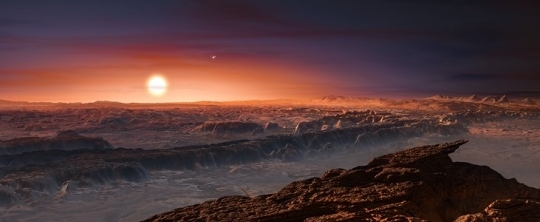Another Earth-Like Planet? Not Really.

An artist’s conception of the newly-discovered planet, Proxima Centauri b
(click for credit)
The internet is alive with exciting news. Space.com says that astronomers have discovered the “Closest Earth-Like Planet.” New Scientist says, “Earth-like planet spotted just 4 light years away.” Livescience.com says, “Found! Potentially Earth-Like Planet at Proxima Centauri Is Closest Ever.” So we’ve finally found an earth-like planet, right? Wrong!
The European Southern Observatory, whose astronomers actually found this new planet, is much more measured in its public announcement of their find. While it gives a few illustrations (like the one above) that are based almost exclusively on imagination alone, the announcement itself carefully discusses what is actually known about the planet. As far as they can tell, this planet is most likely a rocky planet (unlike Jupiter, Saturn, Uranus, and Neptune, which are mostly gas), and it is also possible that the temperature of the planet allows for the existence of water in its liquid phase, which most scientists think is necessary for life. Thus, it is possible that life might exist on the planet.
How did the astronomers at the The European Southern Observatory come to this conclusion? First, they observed the nearest known star to our sun, Proxima Centauri, for an extended amount of time. By analyzing changes in the light that comes from that star, they found that it “wobbles.” Sometimes, it moves towards the earth at about 3 miles per hour, but eventually, it turns around and starts moving away from the earth at about the same speed. This happens repeatedly at intervals of about 11 days. Pretty much the only way this can be explained is if a planet is orbiting the star, tugging it one way and then another as it orbits. Using this information and our understanding of gravity, the mass of the planet (currently being called “Proxima Centauri b”) has been calculated to be at least 30% more than that of earth, and its average distance from Proxima Centauri is about 4 million miles, which puts it 20 times closer to its star than earth is to the sun.
Right now, that’s really all that can be said about the planet with any degree of certainty. However, based on those calculations, some conjectures can be made.
It is hard to understand how a gaseous planet with a mass anywhere near that of earth could be stable so close to a star, so based on the mass of the planet and its distance from Proxima Centauri, astronomers speculate that it must be rocky. Now please understand that the planet itself has not been observed directly. Astronomers conclude it is there and calculate its characteristics based on the way the star Proxima Centauri moves back and forth. Thus, we don’t know that the planet is rocky, but we can say that it probably is.
Also, based on the amount of light that comes from Proxima Centauri and the distance this planet is from the star, it is possible that the planet (or parts of it) stay in a temperature range that would allow water to exist in its liquid form. In contrast to the speculation that the planet is rocky, however, the speculation that it might contain liquid water is very, very uncertain. The star that it orbits is very different from the sun. It is fainter, which is why the planet must be so close to its star to possibly have a temperature that is suited for the presence of liquid water. However, even if there is liquid water, the planet probably has little in common with earth, specifically because it is so close to its star.
For example, the planet either has no day/night cycle, or the day/night cycle is like that of Mercury. Why? When a planet is close to its star, the tidal forces that act between the planet and star tend to “lock” the planet into one of two kinds of rotation. One possibility is that the speed of the planet’s rotation is perfectly synchronized with the speed of its orbit, so the same part of the planet is always facing the star. If this is the case, the planet would have no day/night cycle at all. One side of the planet would always be light, and the other side would always be dark. The other possibility is more complex, where the planet makes three rotations for every two orbits. That’s what it is like for Mercury, which results in a day/night cycle that is very, very different from that of the earth.
Also, because Proxima Centauri b is so close to its star, it is hit with a lot more ultraviolet radiation and X-rays than the earth. In order for life to exist, it must be protected from this dangerous electromagnetic radiation. One way that could happen is for the planet to have an atmosphere that includes gases which absorb such radiation. However, because it has to absorb so much more radiation, the composition of the atmosphere would have to be very different from that of earth’s atmosphere. Alternatively, the life could exist only underground (where it is protected from the radiation), but once again, that would make it much different from earth.
Obviously, a lot more study has to be done to find out what this planet is like and whether or not it might harbor liquid water and/or life. However, based on what we know right now, it is most likely nothing like earth!
Jay L. Wile's Blog
- Jay L. Wile's profile
- 31 followers



